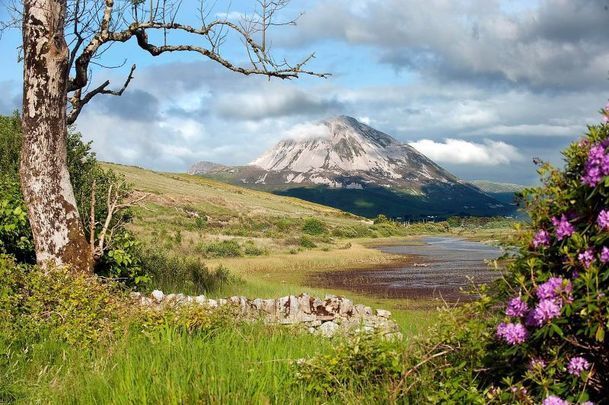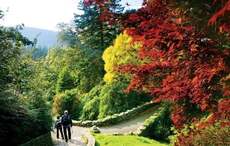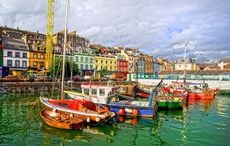Cycling away from the tourist traps to Donegal in the beautiful North West of Ireland.
The Donegal landscape is hilly with wild uplands punctuated by river valleys and pockets of forest. And of course, there’s always the sea. Around the shoreline, Atlantic waves batter ancient rocks to sculpt a spectacular coast of cliffs, inlets, hidden beaches, and quiet settlements.

Are you planning a vacation in Ireland? Looking for advice or want to share some great memories? Join our Irish travel Facebook group.
The people of Donegal are proud and bold. I mean ‘bold’ in the very nicest sense of the word. They have a strong streak of independence and there is a Donegal way of doing things. It can be heard in their conversation and music, seen when they play football and, even, when parking their cars.
We cycled out from Donegal town on a drizzly morning to begin our exploration of the county with the same name. Our plan for the first day was to get to Glencolmcille and take in as much of the coast along the way. The first stop was Killybegs, Ireland’s capital of fishing, where enormous trawlers tie-up along the docks for a quick unload and resupply, before returning to harvest the rich fishing grounds of the northern Atlantic. A gentle but persistent hill made for hard work on the road here and so we gladly leave our bikes by the quays and gawk at the fishing fleet.
Fishing ports are loud places, screeching gulls scrambled for scraps of mackerel from the bulging crates piled up ready for shipment to markets far and wide. I am always fascinated by the work of seafarers – brave people who go to sea in all weather and earn a precarious living quite literally at the edge of the world.
Plan your own trip to Donegal
A light lunch and we were once again trundling out the coast road. At this stage, the weather had cleared and blue sky with patterned cloud enticed us forward. The sea was never far away. This part of Donegal is all about the clash between the mountains and the ocean. The recurrent theme was of lumpy hills interspersed with low coves and sparse townlands. As always, journeys on bicycles are intimate transactions with the landscape and this was no different. A fitness instructor would describe it as ‘interval training’; short bouts of intense climbing followed by a freewheel into the valley, a quick namecheck on where we were, followed by climb and climb again. And so the procession of place names, Fintra, Tullid, Largy, Kille, Bavin, Drimnafinangle, pass fleetingly into our consciousness between hills that provide ever more dramatic views of the coastline.
It was mid-afternoon when we arrived in Carrick, a snug town tucked at the end of the River Glenn estuary. From there we diverted to the sea cliffs at Slieve League, a twelve-mile loop but well worth the effort. As the road turned through a sequence of small fields we waved to a farmer cutting hay the old way with a scythe. We asked how far to the cliffs, ‘Ah it’s a wee bit yet so it is’ he said reassuringly and then added ‘there’s a wee hill up there’. Donegal people use the diminutive ‘wee’ quite a lot. It can be appended to anything from the weather to food and people. The strange thing is that it usually doesn’t mean that something is small. Quite the contrary always be wary if they suggest a wee bit of trouble or, as in this case, a wee hill.
As expected, it was quite a climb up to what was described as the lower car park. The viewing platform was a wee bit further and we needed to push the bikes at several points along the way. What then? Well, only the most magnificent and splendid vista that you can imagine. Look below and it’s a sheer drop to the sea. Look up and across a narrow inlet and the Slieve League mountain towers high, with a sharp ridge along the summit. Scraggy escarpments plunge two thousand feet into distant crashing waves. These are the highest sea cliffs in Europe, over three times higher than the better known Cliffs of Moher. Around us the lower slopes were in full bloom with purple and yellow heathers. The sea breeze was warm with the fresh and salty smell of the ocean. We sat and watched as great black-backed gulls glided along the slopes.
Plan your own Donegal adventure
Back then to Carrick to continue our journey to Glencolmcille. Once we reached the upland open bog we were on our own. It’s a strange place, there are no houses, apart from the road, no evidence of people, just an expanse of wild grass and moorland. Familiar hills in the distance reassured me we were heading for the glen but there was little else by way of road sign or milestone.
We were tired and our usual chatter and banter was replaced by the slow rhythm of the pedals and the synchronicity of our breathing. This is a time when cycling and thinking merge into one and my mind-body drifts off to another world.
The glen is named after Saint Colmcille, often known as one of Ireland’s twelve apostles. In the years after St Patrick, Ireland developed a strong monastic tradition based on scholarship and religious fervor. Saintly men and women, the abbots and abbesses at the time, guided communities devoted to living a simple Christian life. One such leader was Columba who later used the name Columcille meaning ‘dove of the church’. Many places around Donegal and Derry are associated with Columcille and he is often portrayed as a warrior saint fighting off evil monsters and demons.
For me, the most interesting story about Columba was his part in the establishment of an early version of copyright law. The story goes that Finnian, a fellow monk, and former mentor, obtained a version of the Latin bible and brought it to Ireland. This was a big deal at the time as sacred texts were highly prized and a central source of monastic power and prestige. Anyway, Columba inveigled his way to get access to the book and of course, he proceeded to make a copy. Finnian was not pleased when he found out and a great dispute arose between the two scholars. After several attempts at conciliation, the case was finally settled by the King at Tara who pronounced in favor of Finnian and declared “to every cow its calf and to every book its copy”. This has to be one of the earliest legal judgments on the laws of copyright. Columba did not take the ruling lightly and the dispute eventually led to a bloody battle. Not the actions of a saint you might say and Columba later regretted his actions and became the ‘dove’ of the church.
These ramblings kept me amused as we crossed the bog and slowly began our descent into the great Glencolmcille, the epitome of the rural Irish village: churches, ancient and modern, Catholic and Anglican; graveyards, ancient and modern, standing stones, small shops, two pubs, and a folk village. All tucked away in a valley surrounded by mountains and sea. The people here speak Irish and are proud to do so. They talk in gentle phrases with long pauses that I have long associated with people of the hills. That evening, when we arrived, there was a blessing of the graves and the single street was thronged with people and cars. And later as darkness fell, musicians from across Ireland began to gather for the annual fiddlers’ festival. We sat outside under the stars drinking beer and listening to the lilting sound of reels and hornpipes.
It was one of those days that had everything. That night, with the sea air and dreams of wondrous landscapes and quarreling saints, I slept a very deep and satisfying sleep.




Comments